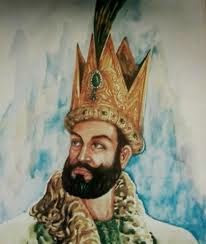 . . |
| Ferocious Md. Ghazni who raided India17 times.khudi.pk |
Md. Ghazni, the most prominent ruler of the Ghaznavid Empire invaded India more than 17 times between 1101 and 1027 with an intention to plunder treasure-laden temples; he conquered Sindh and Multan. In 1025 AD he looted and plundered Somnath and other temples - the worst onslaught ever undertaken by a ruler. With the plundered wealth, he expanded the kingdom and built palatial palaces and led a luxurious life.
Mahmad, (born November 01 in 971 AD), son of Subuktin ascended the throne at the age of 27 and took a vow to invade India every year. The greatest of the Ghaznavids ruled between 998 and 1030, expelled the people of other faiths from Gandhara, made no fewer than 17 raids into northwestern India. Starting from 1000 A.D, he raided the border areas then Jaipal in 1001, Multan in 1006 later Ananadpal and defeated the Hindu king, plundered and looted Nagarcot in 1009. During his mindless rampage looting and destruction of temples in Mathura 1018, Kanuj, Kalinjar in 1919 and at treasures. At last he looted Somnath temple in 1025 and it was something like Eldorado; he amassed mind-boggling treasures one can ever imagine.
Looting was followed in places like Maheshwar, Jwalamukhi, Narunkot and Dwarka. During the period of Mahmud's aggressive invasion, people belonging to other faiths fled from Sindh to escape religious conversion and "sectarian violence.''
Somnath temple, famous for its valuable treasures and beautiful ornamented shrines, had about one thousand priests to serve
 |
| Present day Somnath temple, Gujarat.simplyoffbeat.com |
 |
| SlideShare |
 |
| slideshare.net |
Ref:
Elliot, Sir Henry Miers (1952). The history of India, as told by its own historians: the Muhammadan period, Volume 11. Elibron.com. p. 98.
Carl Brockelmann, Moshe Perlmann and Joel Carmichael, History of the Islamic Peoples: With a Review of Events, 1939-1947, (G.P. Putnam's sons, 1947), 169. – via Questia (subscription required)





.webp)



